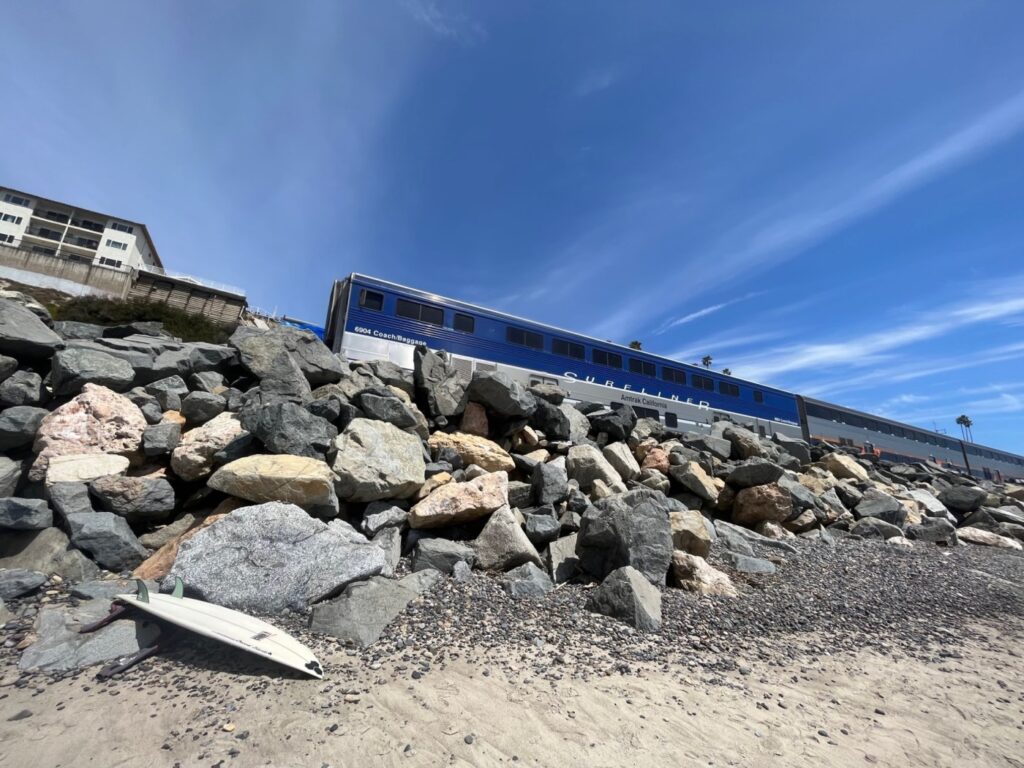
The Orange County Transportation Authority was given the green light to immediately start work to secure a portion of the rail line through San Clemente, though only part of the proposed project earned emergency status.
The California Coastal Commission recently granted a go-ahead for emergency work on a northern section of the coastal tracks in San Clemente. But work toward the south that would involve adding boulders and sand and building a new 1,400-foot-long reinforcement wall on the inland side of the Mariposa Bridge still needs further analysis before moving forward, commissioners decided.
That also delays the rebuilding of the city’s popular coastal beach path destroyed by a landslide.
With the commissioner’s approval for the emergency work, the OCTA’s board of directors this week authorized CEO Darrell E. Johnson to move ahead with the work.
“Our priority remains clear: to move quickly, make the most of the state and federal funding we’ve already secured, and deliver as much of the needed work as possible, as soon as possible,” Johnson said in a statement. “We appreciate the Coastal Commission affirming what we have long recognized — that an emergency exists along this corridor.“
Following weeks of passenger service shuttered by another landslide in January 2024, OCTA officials identified four “hot spot areas” as most vulnerable to catastrophic failure from beach erosion, wave impacts, and slope failure.
Since 2021, emergency response to landslides and damage to this section of the 351-mile Los Angeles-San Diego-San Luis Obispo, or LOSSAN, Corridor has cost taxpayers more than $40 million to restore service. The response to track damage has been both in the form of placing boulders to build up revetments and the construction of containment walls.
“This action enables OCTA to act quickly and decisively to protect our coastal rail line,” OCTA Chair Doug Chaffee, also Orange County’s Fourth District supervisor, said in a statement. “By advancing this emergency work, we are helping to preserve a critical transportation link for Southern California, the region and beyond.”
The full project’s price tag is about $300 million – the funding already secured from state and federal funding sources.
A series of new landslides near Mariposa Point have occurred over the past year and debris and mud are nearing the top of the 12-foot-tall temporary wall constructed in early 2024 when a slope failure forced rail service to shut down again for several months and destroyed the popular beach trail bridge.
Work to put in a retainting wall protecting train tracks from a landslide in San Clemente, CA, was done a few months ago following a slide in Jan. 2024. The OCTA is proposing more rocks and walls, along with sand, to protect the rail. (Photo by Jeff Gritchen, Orange County Register/SCNG)
The Coastal Commission approved emergency work to remove sections of the broken bridge destroyed in the landslide, but commissioners said they needed more information to allow a new 1,400-foot-long catchment wall parallel to the tracks, where a landslide is still active. That also delays plans to restore the beach trail on the ocean side and adding boulders at the Mariposa Beach area.
“We do recognize that some aspects of our proposed solution are complex and have raised questions. We are working closely with Coastal Commission staff and our partners to refine our approach,” Johnson said during Monday’s OCTA board meeting. “We do remain committed to working swiftly and getting the work done.”
In the areas of North Beach approved for emergency work, an estimated 7,650 tons of boulders will be added along the tracks. It’s not yet known when that work will start, but it is estimated to take about a month to complete.
A freight train hauled in big rock boulders to North Beach in San Clemente in 2021. An estimated 7,650 tons more boulders will be dropped at the same location in coming months, with sand expected to follow in 2026. (Photo by Laylan Connelly/SCNG)
The second part of the plan will replenish North Beach with about 240,000 cubic yards of sand to provide the tracks a buffer from the ocean. That part is more complicated, requiring timing to the dredger’s schedule and additional approvals through regulatory agencies.
Johnson, in a presentation to the board, said that work will likely get underway in 2026, and be finished in 2027.
Fifth District Supervisor Katrina Foley, who also sits on the OCTA board, said South County beaches have eroded for decades without receiving adequate sand renourishment.
“This inaction caused widespread erosion, threatening our ocean economy, coastal rail corridor, and endangering our national defense and commerce,” she said.
Foley voiced frustration with the time it will take to get sand on the beach.
“It’s very disappointing that we’re taking so long to get this one critical part of the project complete,” she said. “In all the work we’ve done to get the emergency permit, it’s just really an emergency permit for rocks. So that’s disappointing.”
OCTA officials will still need to figure out the next steps for the southern end of the project, near San Clemente State Beach, where 2,100 tons of rip rap and 33,000 tons of additional material for an engineered revetment are proposed, as well as 300,000 cubic yards of sand.
Surfrider Foundation Senior California Policy Coordinator Mandy Sackett said the group is grateful the Coastal Commission didn’t authorize emergency armoring at the southern end of San Clemente State Beach, “an important public beach, surf spot and campground,” concerned that placing more boulders could have an impact on that stretch of beach.
“Haphazardly piling more boulders on our beaches under emergency permits is not climate resilience, it’s a slow erosion of our coast and our public trust lands. We need long-term solutions that protect both the rail line and beach access,” she said. “True coastal resilience requires thoughtful planning, real alternatives to armoring, and a commitment to preserving our beaches, not just defending infrastructure at all costs.”
The OCTA has faced resistance to the plans to add boulders at the beach, but argues the proposal is about 95% sand and 5% riprap, and would be “the largest volume of sand ever placed on San Clemente beaches in a single effort to protect the rail line and stabilize the coastline.”
San Clemente City Manager Andy Hall said he hoped the project could have moved forward as one, instead of being broken up by the Coastal Commission, with concern that the rocks will be put in place, but delays could occur with sand delivery.
“Now you’ll see the revetment repaired, but now we have to question and push to make sure sand gets delivered as well. I think OCTA has the best of intentions. Until we make it as easy to put sand on the beach as it is to put rip rap, sand will always lag behind,” Hall said. “Somehow, we have to make sand cheaper and easier to get on the beach … sand shouldn’t be, but it is, more complicated.”
Related Articles
Wedge surfers chased out of water by sea lion, the latest in a string of aggressive behavior at beaches
Laguna Beach holds townhall in advance of anticipated summer crowds
How pick for LA28 surfing contest could impact tourism, exposure for nearby San Clemente
Olympics spotlight once again will shine on Orange County area
LA28 Olympic surfing set for Lower Trestles, south of San Clemente
